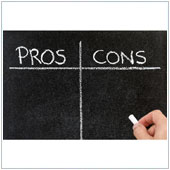Microsoft has long been a software and peripheral manufacturer. Sure there is the Xbox, and the Xbox 360, but these devices serve a largely home-oriented market. With the recent release of Windows 8, Microsoft also decided it was time to move into the mobile market, and has recently launched their first tablet, the Microsoft Surface. The question is, is it any good for business users?
The release of the Surface Windows RT version – the Pro version is slated to be released in January 2013 – has seen largely mixed reviews, leaving business users much to think about. To help, here’s a list of four pros and cons of the Surface (note, these only reflect the released RT version).
Pros
The keyboard-case
Because of a larger surface area, more glass and generally more to break, users want to keep their tablets safe from daily use. The easiest way to do so is with a case. Microsoft decided that a case wasn’t good enough, so they put a keyboard on it. There are two different cases available, one with a soft keyboard and the other with a hard plastic keyboard.
These keyboards are essentially a laptop keyboard, complete with a trackpad and ‘mouse buttons’ that allow users to right and left-click. From usage reports, they provide good tactile feedback, so you will know you are typing, and generally work well once you get used to them. The cool thing is, both keyboards don’t add a lot of dimension to the case and they snap in place with magnets. Kudos to Microsoft for developing such a cool system that enables users to almost replace the laptop.
Essential apps
The Surface comes with Microsoft Office 2013 already installed, the first device to do so, meaning all of your Microsoft capabilities are available from the get-go. As this is a Microsoft product, you’ll be able to access the cloud versions of Microsoft’s programs pretty much from your first sign in.
Windows 8 RT
Windows 8 is a drastic change from previous versions of Windows. The best thing about it, is the new User Interface is designed with touchscreen users in mind. When you use it on a tablet, it feels intuitive and unlike any other OS out there.
The display
There’s a lot of numbers associated with the display of the Surface. With a resolution of 1366×768, and a 10.6 inch display, this tablet is bigger than the iPad, but with a lower resolution. While the resolution is lower, it actually looks quite good and most users probably won’t notice much of a difference when comparing it to displays of similar devices.
For the resolution enthusiasts, you’ll know that 1366X768 is an aspect ratio of 16:9. This means the display is meant to be viewed in landscape mode. In other words, you will be able to see more, much like watching a movie in Widescreen.
Cons
Windows 8 RT
Microsoft and other tablet manufacturers have confused users. The main thing you need to know about the Surface is that it uses the RT version of Windows 8. This version was developed for devices using ARM processors and while it looks exactly the same as every other version of Windows 8, there is one major issue: RT doesn’t support programs written for Legacy Windows systems (Windows 7 or older). That’s right, pretty much every program written since the dawn of the OS won’t work on Windows 8 RT devices unless the developer creates a Windows 8 RT version.
This one feature alone is enough to essentially cripple the Surface in terms of business use, especially if you still rely on older software or computers. If you operate completely in the cloud, this is less of an issue (not a problem actually).
The price
The Surface doesn’t come cheap. The base 32GB model costs USD$499, the same as the base iPad. Want that fancy keyboard cover? Add in another USD$120 for the soft cover (unless you get the 32GB version with it, then it’s USD$599 for the tablet and cover). Want the harder, more keyboard-like cover? Add in USD$130. At these prices, many small businesses will find it hard to justify the purchase.
Lack of other apps
Outside of the Microsoft related apps, the number of apps available is rather paltry. While this may seem like a major con, remember: This is a new platform, think back to Android, or even iTunes, when it first launched; slim pickings. This will likely change, with many of the ‘essential’ apps being made available on the Windows Store in the near future, if they aren’t already.
The design
The general design of the tablet is a thing users will either love or hate. Because of the resolution and aspect ratio, this tablet is meant to be held in landscape mode. Hold it as you would a smartphone and it looks really squished. Just looking at the tablet, you can see it’s meant to live on a desktop. There have been complaints that using the Surface and keyboard on your lap is nearly impossible. This could be a problem if you need to do work without a flat surface.
Now, we aren’t saying the Surface is a bad product, it could be a great replacement for casual users looking to get rid of their laptop. For businesses however, it’s better to wait until the Pro version comes out, as from what can be found on the Internet, it sounds like the Pro could very well be a laptop killer. If you’d like to learn more about the Surface, or how tablets can be used in your business, please give us a call.
Published on 23rd November 2012 by Jeanne DeWitt.


